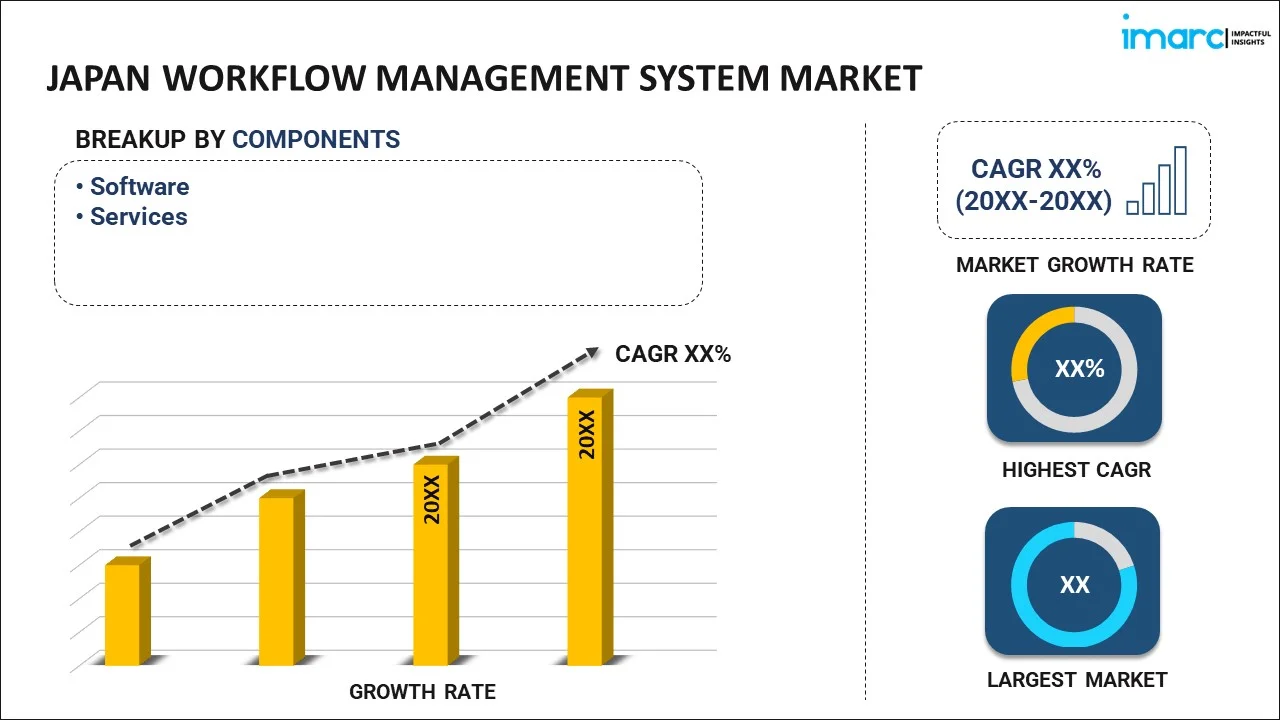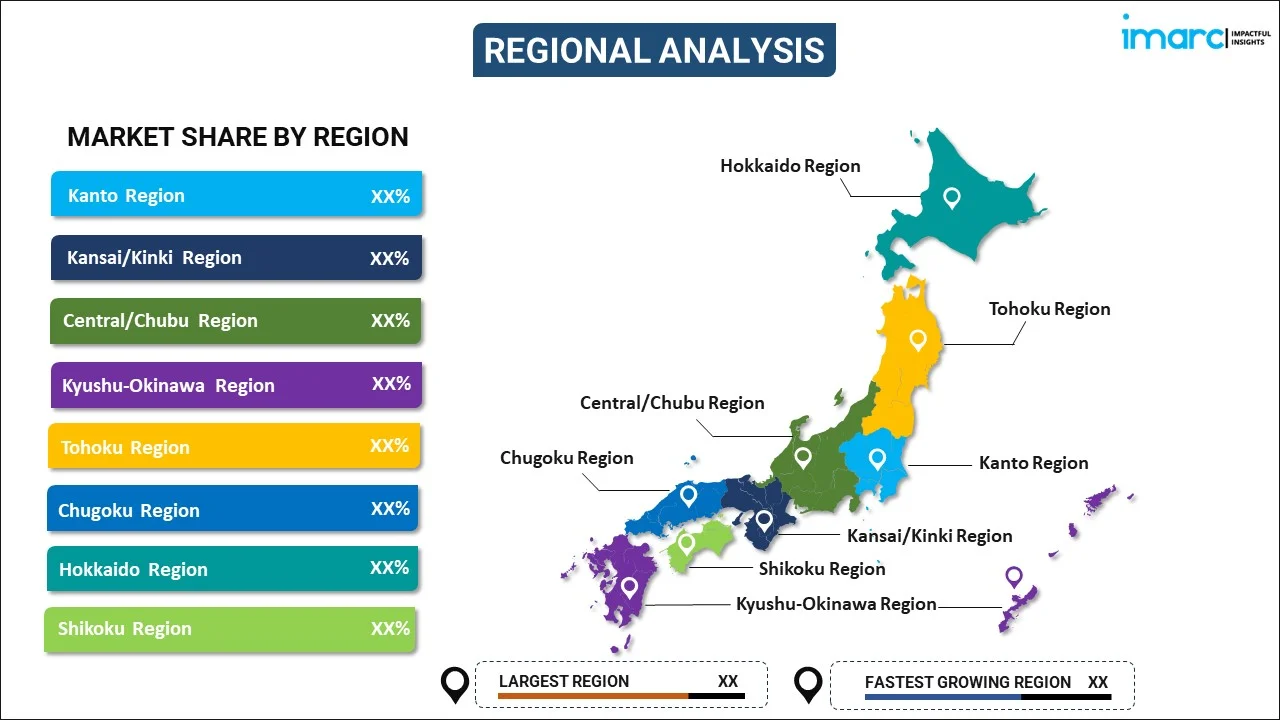
Japan Workflow Management System Market Report by Component (Software, Services), Deployment Type (Cloud-Based, On-Premises), Vertical (BFSI, Healthcare, Energy, Retail, IT and Telecom, Transportation and Logistics, Education, and Others), and Region 2025-2033
Market Overview:
Japan workflow management system market size reached USD 597.3 Million in 2024. Looking forward, IMARC Group expects the market to reach USD 5,905.8 Million by 2033, exhibiting a growth rate (CAGR) of 29.00% during 2025-2033. The increasing demand for artificial intelligence and machine learning algorithms to optimize workflows, predict process bottlenecks, and suggest improvements, is driving the market.
|
Report Attribute
|
Key Statistics
|
|---|---|
|
Base Year
|
2024 |
|
Forecast Years
|
2025-2033
|
|
Historical Years
|
2019-2024
|
| Market Size in 2024 | USD 597.3 Million |
| Market Forecast in 2033 | USD 5,905.8 Million |
| Market Growth Rate (2025-2033) | 29.00% |
A workflow management system (WMS) is a software solution designed to streamline and automate business processes, ensuring efficient task execution and improved collaboration within organizations. It enables the systematic design, execution, monitoring, and optimization of workflows by defining a sequence of tasks and their dependencies. Key features of a WMS include workflow modeling tools, task assignments, notifications, and reporting capabilities. Users can create custom workflows tailored to their specific needs, allowing for standardized and repeatable processes. These systems often integrate with other software applications, databases, and systems to facilitate data exchange and enhance productivity. WMSs offer several benefits, such as increased productivity, reduced errors, better compliance, and enhanced visibility into workflow progress. They are particularly valuable in industries with complex and regulated processes, such as healthcare, manufacturing, and finance, where precise task orchestration is essential. Overall, a WMS empowers organizations to optimize their operations, deliver consistent results, and adapt to changing business requirements efficiently.
Japan Workflow Management System Market Trends:
The workflow management system market in Japan is poised for substantial growth due to several key drivers. Firstly, the increasing demand for streamlined business processes has propelled the adoption of these systems. Moreover, in an era of digital transformation, organizations are striving to enhance efficiency, and WMS offers a compelling solution. Additionally, the proliferation of remote work arrangements has underscored the need for robust workflow tools, facilitating collaboration across dispersed teams. Furthermore, the growing emphasis on compliance and regulatory requirements has pushed businesses to invest in WMSs, ensuring adherence to industry-specific standards. Furthermore, the advent of cloud computing and the accessibility it offers have made these systems more accessible to a wider range of businesses, regardless of their size. Furthermore, the integration of artificial intelligence and machine learning capabilities within WMSs is set to revolutionize the market by automating repetitive tasks and providing data-driven insights. In conclusion, the convergence of these drivers is fueling the expansion of the WMS market in Japan, making it a dynamic and evolving sector with substantial growth potential.
Japan Workflow Management System Market Segmentation:
IMARC Group provides an analysis of the key trends in each segment of the market, along with forecasts at the country level for 2025-2033. Our report has categorized the market based on component, deployment type, and vertical.
Component Insights:

- Software
- Services
The report has provided a detailed breakup and analysis of the market based on the component. This includes software and services.
Deployment Type Insights:
- Cloud-Based
- On-Premises
A detailed breakup and analysis of the market based on the deployment type have also been provided in the report. This includes cloud-based and on-premises.
Vertical Insights:
- BFSI
- Healthcare
- Energy
- Retail
- IT and Telecom
- Transportation and Logistics
- Education
- Others
The report has provided a detailed breakup and analysis of the market based on the vertical. This includes BFSI, healthcare, energy, retail, IT and telecom, transportation and logistics, education, and others.
Regional Insights:

- Kanto Region
- Kansai/Kinki Region
- Central/ Chubu Region
- Kyushu-Okinawa Region
- Tohoku Region
- Chugoku Region
- Hokkaido Region
- Shikoku Region
The report has also provided a comprehensive analysis of all the major regional markets, which include Kanto Region, Kansai/Kinki Region, Central/ Chubu Region, Kyushu-Okinawa Region, Tohoku Region, Chugoku Region, Hokkaido Region, and Shikoku Region.
Competitive Landscape:
The market research report has also provided a comprehensive analysis of the competitive landscape. Competitive analysis such as market structure, key player positioning, top winning strategies, competitive dashboard, and company evaluation quadrant has been covered in the report. Also, detailed profiles of all major companies have been provided.
Japan Workflow Management System Market Report Coverage:
| Report Features | Details |
|---|---|
| Base Year of the Analysis | 2024 |
| Historical Period | 2019-2024 |
| Forecast Period | 2025-2033 |
| Units | Million USD |
| Scope of the Report | Exploration of Historical and Forecast Trends, Industry Catalysts and Challenges, Segment-Wise Historical and Predictive Market Assessment:
|
| Components Covered | Software, Services |
| Deployment Types Covered | Cloud-Based, On-Premises |
| Verticals Covered | BFSI, Healthcare, Energy, Retail, IT and Telecom, Transportation and Logistics, Education, Others |
| Regions Covered | Kanto Region, Kansai/Kinki Region, Central/ Chubu Region, Kyushu-Okinawa Region, Tohoku Region, Chugoku Region, Hokkaido Region, Shikoku Region |
| Customization Scope | 10% Free Customization |
| Post-Sale Analyst Support | 10-12 Weeks |
| Delivery Format | PDF and Excel through Email (We can also provide the editable version of the report in PPT/Word format on special request) |
Key Questions Answered in This Report:
- How has the Japan workflow management system market performed so far and how will it perform in the coming years?
- What has been the impact of COVID-19 on the Japan workflow management system market?
- What is the breakup of the Japan workflow management system market on the basis of component?
- What is the breakup of the Japan workflow management system market on the basis of deployment type?
- What is the breakup of the Japan workflow management system market on the basis of vertical?
- What are the various stages in the value chain of the Japan workflow management system market?
- What are the key driving factors and challenges in the Japan workflow management system?
- What is the structure of the Japan workflow management system market and who are the key players?
- What is the degree of competition in the Japan workflow management system market?
Key Benefits for Stakeholders:
- IMARC’s industry report offers a comprehensive quantitative analysis of various market segments, historical and current market trends, market forecasts, and dynamics of the Japan workflow management system market from 2019-2033.
- The research report provides the latest information on the market drivers, challenges, and opportunities in the Japan workflow management system market.
- Porter's five forces analysis assist stakeholders in assessing the impact of new entrants, competitive rivalry, supplier power, buyer power, and the threat of substitution. It helps stakeholders to analyze the level of competition within the Japan workflow management system industry and its attractiveness.
- Competitive landscape allows stakeholders to understand their competitive environment and provides an insight into the current positions of key players in the market.
Need more help?
- Speak to our experienced analysts for insights on the current market scenarios.
- Include additional segments and countries to customize the report as per your requirement.
- Gain an unparalleled competitive advantage in your domain by understanding how to utilize the report and positively impacting your operations and revenue.
- For further assistance, please connect with our analysts.
 Inquire Before Buying
Inquire Before Buying
 Speak to an Analyst
Speak to an Analyst
 Request Brochure
Request Brochure
 Request Customization
Request Customization




.webp)




.webp)












